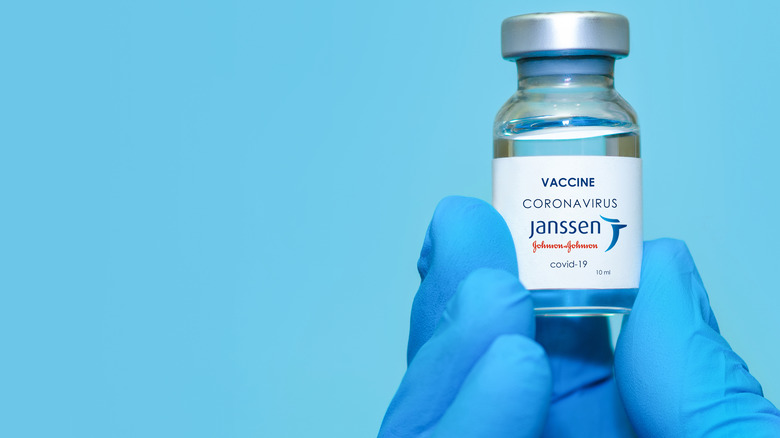Side Effects Of Johnson & Johnson's COVID-19 Booster Shot Explained
Experts suggest that booster shots may help extend the effects of the COVID-19 vaccine, and those who received the Janssen/Johnson & Johnson vaccine at least two months ago are eligible for the booster shot (via CDC). However, in mid-December 2021, the CDC released a statement "expressing a clinical preference for individuals to receive an mRNA COVID-19 vaccine over Johnson & Johnson's COVID-19 vaccine." Still, the organization acknowledged that any COVID-19 vaccine is still better than no COVID-19 vaccine and explained that people who are "unable or unwilling to receive an mRNA vaccine will continue to have access to Johnson & Johnson's COVID-19 vaccine."
For those still wanting or needing a Johnson & Johnson booster, you may be wondering what potential side effects — both common and rare — you should expect. According to clinical trial data and experts, here's what you should know prior to receiving your much-anticipated booster shot.
Injection site pain
Injection site pain is the most common side effect among those vaccinated with the Johnson & Johnson initial vaccine and/or booster (via FDA). Note that regardless of which vaccine or booster you get, the vaccine is injected into the deltoid muscle of the arm, the area of the arm largely responsible for range of motion.
Subsequent pain, swelling, and redness at the booster shot injection site can happen for various reasons. One reason may be due to an immune response initiated by the vaccine. In a nutshell, the science behind the vaccine is to make our bodies think we've been infected by the virus, according to Verywell Health. In trying to defend our bodies, our immune system sends white blood cells to fight the invader. This can cause inflammation and pain as a result. Secondly, because the shot is administered in a part of the arm we move frequently, simple movements throughout the day may signal pain. Arm pain is generally harmless but an annoyance. However, it typically resolves within a few days. In order to minimize the pain, it's recommended to apply a cold compress and use/exercise the arm frequently (via CDC).
Fatigue and headache
Fatigue and headache are categorized as mild side effects of the Johnson & Johnson booster shot. Clinical trial data showed that about 29% of adults 60 and older experienced these two side effects after getting the booster (via AARP). As such, many have turned to over-the-counter medications such as ibuprofen, acetaminophen, and aspirin to help alleviate the pain. However, it's suggested that these medications be used only after receiving the booster shot and on an as-needed basis rather than before the shot as a preventive measure, according to the CDC. Additionally, anyone considering over-the-counter medications should consult their physician first. Some individuals may have medical conditions that make such medications unsafe to take.
Interestingly, when it came to individuals with post-vaccine fatigue, researchers suggested the placebo effect may have been to blame. One study showed that 23% of participants complained of fatigue after receiving a placebo dose of the COVID-19 vaccine (via National Geographic). The same could conceivably hold true for the booster shot.
Muscle aches and nausea
Muscle aches are considered a common side effect of the Johnson & Johnson vaccine and booster, according to the FDA. This may manifest as a dull ache and pain that radiates throughout the body. If you've ever experienced body aches while fighting the flu, the effect is similar after the booster shot. Similar to headache, it's recommended that those experiencing body aches consider using over-the-counter pain relief to manage the discomfort (via CDC). Other simple ways to alleviate body pain can include a cool bath or soaking in Epsom salts, according to Yale Health.
In addition to muscle aches, nausea is another uncomfortable and common side effect of the vaccine and booster shot (via FDA). Simple ways to minimize nausea include drinking ginger tea and drinking plenty of fluids that replenish electrolytes. While nausea can be a symptom of the booster, it's also a common symptom of general dehydration. If you're not feeling well to begin with, you may be drinking fewer fluids than normal.
While nausea and body aches may both impede one's ability to perform daily tasks to the best of their ability, these side effects typically resolve in one to two days and are generally not considered dangerous or life-threatening.
Less common side effects
Fainting has been reported as a possible, yet uncommon, side effect of the Johnson & Johnson shot. Health experts suggest this has less to do with the vaccine itself and more to do with the anxiety surrounding any shot or vaccination.
Related symptoms that generally accompany fainting are rapid breathing, a drop in blood pressure, and tingling sensations throughout the body. According to the Vaccine Adverse Event Reporting System (VAERS), 653 cases of fainting occurred out of about 8 million Johnson & Johnson vaccine administrations (via CDC). Such incidences occurred during the 15-minute monitoring session post-vaccination.
Additionally, allergic reactions may occur as a result of the booster shot. One such reaction is anaphylaxis, a life-threatening allergic reaction. Compared to the Moderna and Pfizer vaccine, there are fewer reported cases of allergic reactions in the Johnson & Johnson vaccinated population, according to CNBC. It's recommended that if you had an allergic reaction to an initial dose of the vaccine, you should not get another dose of the same brand.
Adverse effects and when to seek medical attention
Research suggests women may have higher risks for common side effects as well as adverse effects from vaccination compared to men. Several theories abound including differences in hormones, the fact that women typically have stronger immune responses, and women tend to report symptoms and seek medical attention more frequently than men (via National Geographic).
While common side effects may affect daily living, they shouldn't last more than a few days. Adverse effects, on the other hand, can pose a dangerous health risk. One adverse risk associated with the Johnson & Johnson COVID-19 vaccine and booster is thrombocytopenia syndrome (TTS), according to Memorial Sloan Kettering. TSS is a serious type of blood clotting disorder that presents in tandem with low blood platelets. People who developed TSS after receiving the Johnson & Johnson vaccine developed symptoms one to two weeks later. This condition has been most highly reported by women between the ages of 18 and 49, according to the FDA.
Another serious side effect called Guillain-Barré syndrome, a severe neurological disorder, was reported within 42 days of receiving the Janssen/Johnson & Johnson COVID-19 vaccine (via CDC). Other serious side effects that require emergency care include shortness of breath, stomach pain that won't go away, severe headaches and blurred vision, pain in the chest, and swelling of the legs (via Mayo Clinic).






